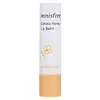What's inside
What's inside
 Key Ingredients
Key Ingredients

 Benefits
Benefits

 Concerns
Concerns

 Ingredients Side-by-side
Ingredients Side-by-side

Petrolatum
EmollientPolyglyceryl-2 Triisostearate
EmulsifyingDiisostearyl Malate
EmollientParaffinum Liquidum
EmollientJojoba Esters
EmollientHydrogenated Polyisobutene
EmollientPolyethylene
AbrasiveMeadowfoam Delta-Lactone
Skin ConditioningPhytosteryl Hydroxystearate
Skin ConditioningHydrogenated Coco-Glycerides
EmollientEuphorbia Cerifera Wax
Microcrystalline Wax
Emulsion StabilisingMangifera Indica Seed Butter
Skin ConditioningCeresin
Emulsion StabilisingPrunus Amygdalus Dulcis Oil
Skin ConditioningTrihydroxystearin
Skin ConditioningPhenoxyethanol
PreservativeCaprylyl Glycol
EmollientParfum
MaskingGlyceryl Caprylate
EmollientTocopheryl Acetate
AntioxidantCI 19140
Cosmetic ColorantCI 15985
Cosmetic ColorantTocopherol
AntioxidantTbhq
AntioxidantWater
Skin ConditioningBrassica Campestris Seed Oil
Skin ConditioningGlycerin
HumectantButylene Glycol
HumectantCamellia Sinensis Leaf Extract
AntimicrobialCamellia Japonica Leaf Extract
Skin ConditioningOrchid Extract
Skin ConditioningOpuntia Coccinellifera Fruit Extract
Skin ConditioningCitrus Unshiu Peel Extract
MaskingHoney Extract
HumectantEthylhexylglycerin
Skin ConditioningPetrolatum, Polyglyceryl-2 Triisostearate, Diisostearyl Malate, Paraffinum Liquidum, Jojoba Esters, Hydrogenated Polyisobutene, Polyethylene, Meadowfoam Delta-Lactone, Phytosteryl Hydroxystearate, Hydrogenated Coco-Glycerides, Euphorbia Cerifera Wax, Microcrystalline Wax, Mangifera Indica Seed Butter, Ceresin, Prunus Amygdalus Dulcis Oil, Trihydroxystearin, Phenoxyethanol, Caprylyl Glycol, Parfum, Glyceryl Caprylate, Tocopheryl Acetate, CI 19140, CI 15985, Tocopherol, Tbhq, Water, Brassica Campestris Seed Oil, Glycerin, Butylene Glycol, Camellia Sinensis Leaf Extract, Camellia Japonica Leaf Extract, Orchid Extract, Opuntia Coccinellifera Fruit Extract, Citrus Unshiu Peel Extract, Honey Extract, Ethylhexylglycerin
Ingredients Explained
These ingredients are found in both products.
Ingredients higher up in an ingredient list are typically present in a larger amount.
Tocopherol (also known as Vitamin E) is a common antioxidant used to help protect the skin from free-radicals and strengthen the skin barrier. It's also fat soluble - this means our skin is great at absorbing it.
Vitamin E also helps keep your natural skin lipids healthy. Your lipid skin barrier naturally consists of lipids, ceramides, and fatty acids. Vitamin E offers extra protection for your skin’s lipid barrier, keeping your skin healthy and nourished.
Another benefit is a bit of UV protection. Vitamin E helps reduce the damage caused by UVB rays. (It should not replace your sunscreen). Combining it with Vitamin C can decrease sunburned cells and hyperpigmentation after UV exposure.
You might have noticed Vitamin E + C often paired together. This is because it is great at stabilizing Vitamin C. Using the two together helps increase the effectiveness of both ingredients.
There are often claims that Vitamin E can reduce/prevent scarring, but these claims haven't been confirmed by scientific research.
Learn more about Tocopherol